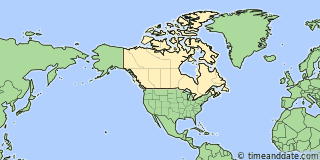Mar 9, 2025, 2:00 am
Mar 10
Forward 1 hour
Mar 10, 2024 - Daylight Saving Time Started
When local standard time was about to reach
Sunday, March 10, 2024, 2:00:00 am clocks were turned forward 1 hour to
Sunday, March 10, 2024, 3:00:00 am local daylight time instead.
Sunrise and sunset were about 1 hour later on Mar 10, 2024 than the day before. There was more light in the evening and less light in the morning.
Also called Spring Forward, Summer Time, and Daylight Savings Time.
More info:
Daylight Saving 2024 Starts in Canada
DST 2024 Starts in the USA
Nov 3
Back 1 hour
Nov 3, 2024 - Daylight Saving Time Ended
When local daylight time was about to reach
Sunday, November 3, 2024, 2:00:00 am clocks were turned backward 1 hour to
Sunday, November 3, 2024, 1:00:00 am local standard time instead.
Sunrise and sunset were about 1 hour earlier on Nov 3, 2024 than the day before. There was more light in the morning and less light in the evening.
Also called Fall Back and Winter Time.
More info:
DST ends in Canada
Hate Clock Changes?
DST Ends in the US
When Does DST Start and End in Canada?
Daylight Saving Time (DST) in Canada starts on the 2nd Sunday in March and ends on the 1st Sunday in November.
Which Provinces and Territories use Daylight Saving Time in 2024

Areas in Canada on standard time all of 2024
Which Provinces and Territories in Canada don't use DST?
Yukon, most of Saskatchewan, some locations in Québec east of 63° westerly longitude (e.g. Blanc-Sablon), Southampton Island, and some areas in British Columbia don't use DST and stay on standard time all year. See table below.
DST in Provinces and Territories in Canada | |||||
|---|---|---|---|---|---|
| Alberta | Mar 10 – Nov 3 | Northwest Territories | Mar 10 – Nov 3 | Quebec (east) | No DST |
| British Columbia (east, northeast, southeast) | No DST | Nova Scotia | Mar 10 – Nov 3 | Quebec | Mar 10 – Nov 3 |
| British Columbia | Mar 10 – Nov 3 | Nunavut | Mar 10 – Nov 3 | Saskatchewan (east, west) | Mar 10 – Nov 3 |
| Manitoba | Mar 10 – Nov 3 | Ontario (northwest) | No DST | Saskatchewan | No DST |
| New Brunswick | Mar 10 – Nov 3 | Ontario | Mar 10 – Nov 3 | Yukon | No DST |
| Newfoundland and Labrador | Mar 10 – Nov 3 | Prince Edward Island | Mar 10 – Nov 3 | ||
Daylight Saving Time History in Canada
- Canada first observed Daylight Saving Time in 1908.
- Canada has observed DST for 112 years between 1908 and 2024 (DST in at least one location).
- Previous time with no Daylight Saving Time was 1913.
- See Worldwide DST Statistics
On July 1, 1908, the residents of Port Arthur, Ontario, today's Thunder Bay, turned their clocks forward by 1 hour to start the world's first DST period. Other locations in Canada soon followed suit. On April 23, 1914, Regina in Saskatchewan implemented DST. The cities of Winnipeg and Brandon in Manitoba did so on April 24, 1916.
DST in Canada Today
It is up to the legislation in each municipality in Canada to decide on the use of DST. As a result, there are some locations don't follow the DST schedule of their in provinces and territories. For example, while British Columbia uses DST, some locations in the province do not. These include Chetwynd, Creston, Dawson Creek, Fort Nelson, and Fort St. John. In Saskatchewan, it is the opposite. Most of the province does not observe DST, except for some locations, including Creighton and Denare Beach. From March 8, 2020, Yukon made DST permanent.
Since 2007, all provinces, territories, and locations in Canada using DST follow the same start and end dates as the United States.
